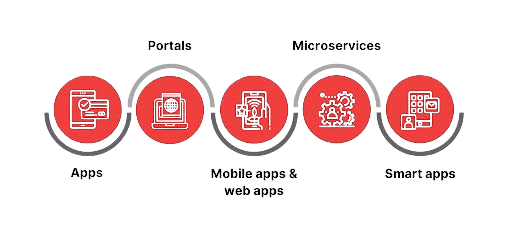
- Introduction to AWS CodeDeploy
- Key Features of AWS CodeDeploy
- Security Features in AWS CodeDeploy
- How AWS CodeDeploy Works
- Integrating AWS CodeDeploy with CI/CD Pipelines
- Deployment Strategies in AWS CodeDeploy
- Comparing AWS CodeDeploy with Other Deployment Tool
- Benefits of AWS CodeDeploy
- Common Use Cases
- Troubleshooting Common AWS CodeDeploy Issues
- AWS CodeDeploy Best Practices
- Conclusion
Introduction to AWS CodeDeploy
In today’s fast-paced software development world, continuous integration and deployment (CI/CD) have become essential for delivering high-quality applications efficiently. AWS CodeDeploy is a fully managed deployment service that helps automate software deployments to various environments, including Amazon EC2 instances, on-premises servers, AWS Lambda, and Amazon ECS. With What is AWS CodeDeploy, developers and DevOps teams can deploy applications quickly, reliably, and with minimal downtime, reducing deployment errors and ensuring a seamless user experience. The service is designed to handle the complexities of application deployment, whether you’re managing a small application or rolling out updates across thousands of instances. This blog will walk you through AWS CodeDeploy, its features, how it works, and best practices to make the most out of this powerful deployment tool.
Key Features of AWS CodeDeploy
AWS CodeDeploy offers several features that make it a preferred choice for automated deployments:
- Automates application deployments, reducing manual work and minimizing errors.
- Allows businesses to release updates faster and more reliably.
- Works with Amazon EC2, The AWS Engineer Lambda, Amazon ECS, and on-premises servers.
- Enables deployment across hybrid environments (both cloud and on-premises)
- Supports in-place and blue/green deployments, allowing seamless rollouts.
- Enables incremental deployments to minimize risks.
- If a deployment fails, AWS CodeDeploy can automatically roll back to the previous version.
- Reduces downtime and prevents major disruptions in production environments.
- Can deploy to thousands of instances simultaneously.
- Ensures zero-downtime deployments with controlled updates.
- Works with AWS CodePipeline, CloudWatch, IAM, and CloudTrail.
- Can be used alongside other DevOps tools like Jenkins, GitHub, and Bitbucket.
- The user defines the application to be deployed in AWS CodeDeploy.
- The application can be a web application, microservice, or backend service.
- The deployment group is a set of instances or Exploring AWS Applications resources where the application will be deployed.
- This can include Amazon EC2 instances, AWS Lambda functions, or on-premises servers
- The AppSpec file is a YAML or JSON file that specifies deployment instructions
- It defines where files should be copied, what scripts should run, and the deployment lifecycle.
- AWS CodeDeploy pulls the latest application version from a specified source (S3, GitHub, or Bitbucket).
- The deployment process follows predefined rules and scripts.
- AWS CloudWatch and CloudTrail provide real-time monitoring and logging.
- If any failures occur, CodeDeploy can trigger an automatic rollback.
- The new application version replaces the existing one on the same instances.
- The deployment happens gradually to minimize downtime.
- Best for: Stable applications with minimal changes.
- The new application version is deployed AWS Course to a separate environment (green) while the existing one remains live (blue).
- Once verified, traffic is shifted to the new version without downtime.
- Best for: Mission-critical applications where zero downtime is required.
- A small percentage of traffic is first routed to the new version.
- If successful, more traffic is gradually shifted until the new version is fully live.
- Best for: Reducing risk in large-scale deployments.
Automated Deployments
Supports Multiple Compute Platforms
Flexible Deployment Strategies
Rollback Capabilities
Scalable and Reliable
Seamless Integration with AWS Services
To Explore AWS in Depth, Check Out Our Comprehensive AWS Online Training To Gain Insights From Our Experts!
Security Features in AWS CodeDeploy
AWS CodeDeploy offers several robust security features that ensure the safety of your deployment process. By using fine-grained IAM permissions, you can control who can trigger deployments and what resources they can access, ensuring only authorized users have deployment access. For secure management of deployment artifacts, Amazon S3 bucket policies are used to restrict unauthorized access. Additionally, Reasons to Learn AWS supports automated compliance audits through integration with AWS Security Hub, allowing businesses to maintain regulatory compliance. It also enforces instance-level security by using EC2 security groups, ensuring that only authorized traffic can interact with your instances during the deployment process.

How AWS CodeDeploy Works
AWS CodeDeploy follows a structured process to ensure smooth, automated deployments. Here’s how it works:
Step 1: Define Your Application:
Step 2: Configure the Deployment Group
Step 3: Create the AppSpec File
Step 4: Deploy the Application
Step 5: Monitor and Verify Deployment
Are You Interested in Learning More About AWS? Sign Up For Our AWS Online Training Today!
Integrating AWS CodeDeploy with CI/CD Pipelines
AWS CodeDeploy integrates seamlessly with a variety of CI/CD tools to automate and streamline your deployment process. It works natively with AWS services like CodeCommit, CodeBuild, and CodePipeline, providing a fully managed workflow for building and deploying applications. CodeDeploy also supports AWS Services multi-stage CI/CD workflows, allowing you to incorporate testing, approval gates, and incremental deployment strategies such as canary releases. For teams using external CI/CD tools, CodeDeploy is compatible with GitLab CI/CD, Azure DevOps, and CircleCI, offering flexibility in deployment workflows. Additionally, deployment status notifications can be configured through Amazon EventBridge or AWS Lambda, enabling automatic responses or alerts to ensure smooth operations.
Deployment Strategies in AWS CodeDeploy
CodeDeploy supports multiple deployment strategies to suit different application needs:
In-Place Deployment (Rolling Deployment):
Blue/Green Deployment:
3. Canary Deployment
Comparing AWS CodeDeploy with Other Deployment Tool
When comparing CodeDeploy to other deployment tools, it becomes clear that each tool serves different purposes. Terraform is primarily focused on infrastructure provisioning and configuration management, whereas AWS CodeDeploy specializes in automating the deployment of applications. In contrast, Kubernetes provides container orchestration and management, which makes it ideal for containerized applications,AWS Training while CodeDeploy is designed for EC2 instances, Lambda functions, and even on-premises deployments. For organizations already invested in the Microsoft ecosystem, Azure DevOps offers a comprehensive CI/CD suite, but AWS CodeDeploy is deployment-centric and integrates well within AWS environments. Finally, while Puppet excels at configuration management, AWS CodeDeploy is tailored to simplifying the deployment phase, ensuring quick, efficient application releases.

Benefits of AWS CodeDeploy
Reduces Deployment Downtime :
AWS CodeDeploy ensures seamless rollouts with its built-in rollback capabilities, minimizing the risk of extended downtime during deployments. If an issue arises with the new version, the service can quickly revert to the previous stable version, maintaining service availability. This feature is particularly beneficial in production environments where downtime can lead to customer dissatisfaction and loss of revenue.
Faster and More Reliable Deployments:
By automating the deployment process, CodeDeploy eliminates human errors, leading to faster and more consistent application releases. Automation also reduces the complexity of the deployment process, allowing teams to focus on other tasks. With integrated monitoring, deployment logs, and notifications, it ensures that the deployment is completed successfully, making it highly reliable.
Cost-Effective
AWS CodeDeploy itself doesn’t incur additional charges beyond the AWS resources used in the deployment process. This makes it a cost-effective solution for businesses AWS Course that want to automate their deployment workflows without incurring unnecessary expenses. You only pay for the underlying resources like EC2 instances or Lambda functions, which means you don’t need to worry about extra costs associated with the deployment tool itself.
Improved Security:
With AWS CodeDeploy, security is enhanced through the integration of IAM roles, which control who can access and deploy applications. Additionally, encryption is used to safeguard the integrity and confidentiality of the deployment process, ensuring that only authorized users can trigger deployments. This helps to prevent unauthorized access and ensures that sensitive data remains secure throughout the deployment lifecycle.
Cross-Platform Deployment:
AWS CodeDeploy supports a variety of deployment targets, including EC2 instances, Lambda functions, and on-premises servers, making it versatile across different infrastructure environments. Whether you’re using cloud-based resources or maintaining on-premises systems, CodeDeploy can handle deployments seamlessly, enabling a hybrid infrastructure approach. This flexibility allows organizations to adopt a consistent deployment methodology across diverse platforms.
Looking to Master in AWS ? Discover the AWS Master Program Training Course Available at ACTE Now!
Common Use Cases
AWS CodeDeploy is used in various industries for automated, reliable deployments:
- Web Application Deployment – Deploy new versions of web applications hosted on EC2 instances.
- Microservices Deployment – Easily roll out updates to AWS Lambda functions and ECS containers.
- Serverless Application Deployment – Deploy AWS Storage Services,Lambda functions environments.
- Hybrid Cloud Deployments – Extend AWS CodeDeploy to on-premises servers, ensuring consistency.
- Disaster Recovery & Rollback – Quickly revert to a previous stable version in case of deployment failure.
Troubleshooting Common AWS CodeDeploy Issues
When issues arise during deployment, AWS CodeDeploy provides various troubleshooting strategies to resolve common problems. For example, permission denied errors can be resolved by ensuring that the IAM roles associated with EC2 instances have the necessary policies to access CodeDeploy. AppSpec file issues such as syntax errors or missing instructions can be fixed by validating the YAML/JSON format and ensuring proper sequence of scripts. If health checks fail, application logs can be examined to identify underlying issues, and ensuring the EC2 instance is in a healthy state before redeployment is crucial. Finally, for long deployment times, optimizing deployment scripts and using parallel deployment strategies can help speed up the process and reduce bottlenecks.
Want to Learn About AWS? Explore Our AWS Interview Questions and Answers Featuring the Most Frequently Asked Questions in Job Interviews.
AWS CodeDeploy Best Practices
To ensure smooth and efficient deployments, follow these best practices:
- Use Blue/Green Deployment for Critical Applications – Avoid downtime and reduce risks by deploying new versions separately.
- Automate Deployment Testing – Use AWS CodePipeline to integrate testing before deployment.
- Implement Rollback Strategies – Always configure automatic rollbacks to handle failures.
- Monitor Deployments with AWS CloudWatch – Track logs and performance metrics to detect issues early.
- Secure Deployments with IAM Roles – Restrict access to ensure only authorized users can trigger deployments.
Conclusion
AWS CodeDeploy is a powerful, automated deployment service that enables businesses to deploy applications reliably, quickly, and with minimal downtime. Whether you are managing EC2 instances, Lambda functions, or on-premises servers, CodeDeploy simplifies the process while ensuring security and scalability. By leveraging various deployment strategies, integrating with AWS services, and following best practices, organizations can achieve seamless continuous delivery (CD) with minimal risk. If you’re looking for a cost-effective, scalable, and automated deployment solution, AWS CodeDeploy is the ideal choice!





